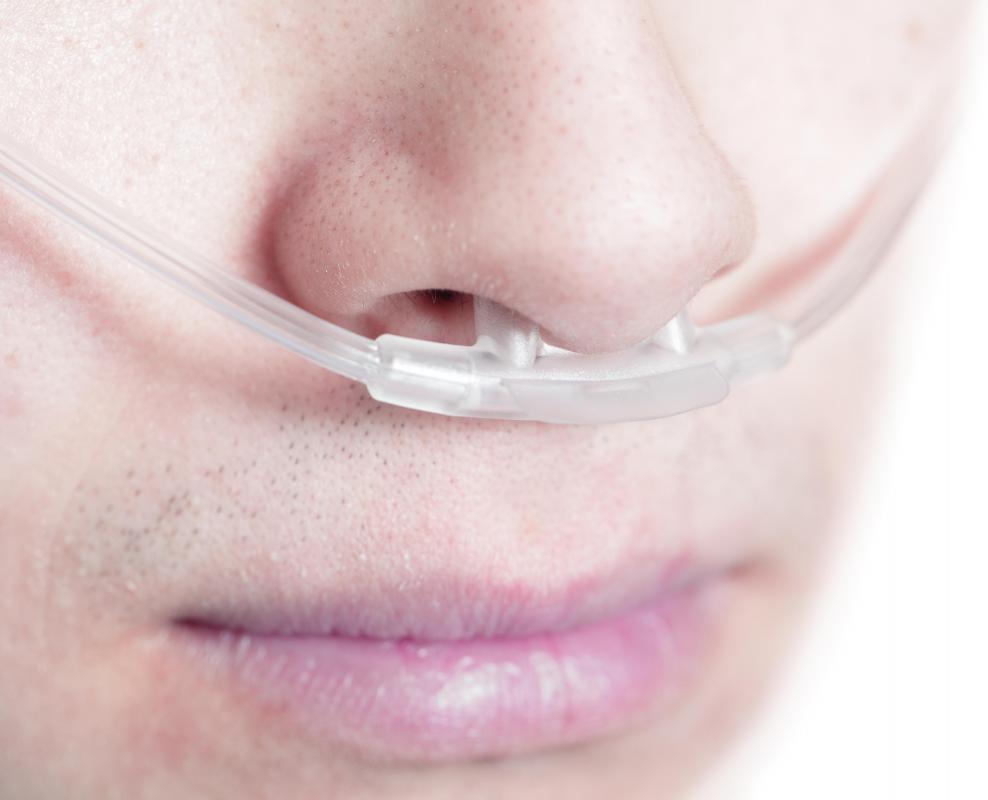At WiseGEEK, we're committed to delivering accurate, trustworthy information. Our expert-authored content is rigorously fact-checked and sourced from credible authorities. Discover how we uphold the highest standards in providing you with reliable knowledge.
What Are the Signs of Hypoxia?
Common signs of hypoxia include extreme shortness of breath, confusion, and uncoordinated movements. In hypoxia, a patient does not have enough oxygen circulating in the blood. This leads to oxygen deprivation in the brain as well as organ damage. If the patient does not receive treatment, cerebral hypoxia can set in and the patient may experience permanent brain damage or death.
Shortness of breath is the classic indicator of hypoxia. The patient's breathing may be labored and he could gasp for air but still complain of not getting enough. Patients may also wheeze when they breathe because of disease or obstruction in the airways. As the oxygen deprivation sets in, the extremities can turn blue and the patient will develop neurological symptoms like an unsteady gait, altered level of consciousness, and confusion. If the patient falls asleep, he may be difficult to rouse.

Patients are at risk of hypoxia at high altitudes and if they have underlying diseases like chronic obstructive pulmonary disorder (COPD) or asthma. Hypoxia can also occur if there are toxins in the air, or when smoke or heavy gases displace breathable air. Likewise, strangulated patients will typically display signs of hypoxia. Patients may experience headaches and fluid retention in addition to other symptoms of hypoxia. Nausea and a general feeling of fatigue and malaise may also set in.

If the signs of hypoxia appear in a patient, it is critical to get help. Partial oxygen deprivation can have serious long term consequences. Treatment usually involves supplying the patient with oxygen to get the blood oxygen levels up. As the patient stabilizes, the doctor can perform some diagnostic tests to find out why the patient has a problem and develop an appropriate treatment plan. Patients may need permanent oxygen supplementation, medications, surgery, and other options to recover.

First aid for a person who appears to have the signs of hypoxia can include moving the person out of an area where the air quality is dubious, as well as loosening clothes to make sure the airway is not obstructed with something like a tight collar. If the patient carries medications for asthma or other lung conditions, these should be administered. In the event the patient stops breathing, rescue breathing to force some oxygen into the lungs while waiting for emergency personnel is advised. This can reduce the risk of brain damage caused by an inadequate supply of oxygen.
AS FEATURED ON:
AS FEATURED ON:


















Discussion Comments
@turquoise-- I think those symptoms are not the earliest symptoms to be seen. I'm not a doctor, but I suffered from hypoxia while hiking. As I went up to higher elevations, I had more and more difficulty breathing and started wheezing at one point.
I thought that I was just going too fast but the rest of the people in my group were worried and so I had to go back down with one other person. I felt a little better going down but still made a visit to the nearest ER. The doctor there told me that I did the right thing. He said that if I had insisted on going up, I would have developed severe hypoxia symptoms like confusion and difficulty walking.
Apparently once these more severe signs start, it means that the brain has started getting damaged from the lack of oxygen. So it's very serious. I think people should not wait until the confusion hits to seek treatment.
My sister is a flight attendant and she told me that all of the flight attendants as well as the pilots are trained to notice signs and symptoms of hypoxia. Apparently, they are at high risk for it because if something goes wrong in the aircraft, the oxygen supply might be affected and the crew can develop hypoxia fairly quickly.
My sister told me that if there is a problem the crew has to keep an eye on themselves and the pilots and look for symptoms like inattentiveness, lack of coordination, difficulty making decisions and confusion.
These are early signs of hypoxia and if it is not noticed early on, crew members can lose consciousness. I can't imagine how traumatic that would be if it happened to the pilots who have to fly the plane.
When I went to rural India as part of a school program in college, many infants in the village we stayed at had blue baby syndrome. They would literally turn blue and stay that way until they saw a doctor and changed their water source.
I found out later that blue baby syndrome is actually hypoxia. Most of the water that the villagers used came from wells and I read later that some toxins and chemicals in well water can cause hypoxia. And turning blue is one of the medical symptoms of it.
The interesting part was that the adults looked fine. I guess blue baby syndrome only happens to infants.
Post your comments